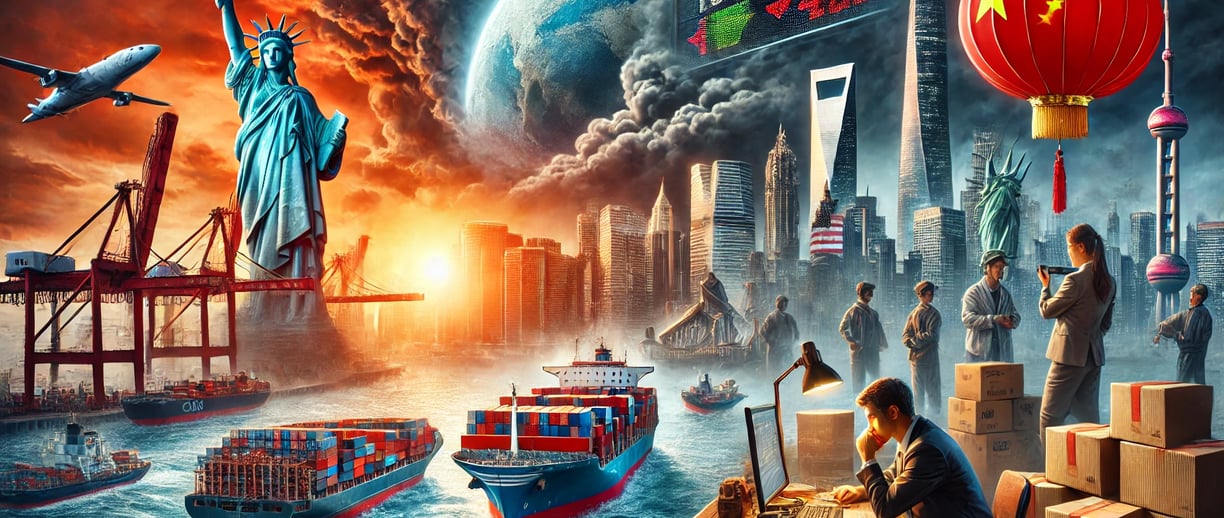Navigating the New Trade Terrain: Challenges of the Trump Administration's 2025 Tariffs
Understanding the Impacts on Global Trade, Domestic Industries, and Consumers
3/4/20252 min read


In a bold move to reshape international trade dynamics, the Trump Administration has implemented substantial tariffs: a 25% levy on imports from Canada and Mexico, and an increase from 10% to 20% on goods from China. These measures aim to address concerns over illegal immigration, drug trafficking, and trade imbalances. However, they introduce a complex web of challenges affecting global trade, domestic industries, and consumers.
Global Economic Ripples
The immediate global reaction has been one of heightened economic uncertainty. Financial markets worldwide have experienced significant volatility, with major indices such as the S&P 500 and Nasdaq witnessing notable declines. This turbulence reflects investor anxiety over potential disruptions in international trade and economic growth. https://www.theguardian.com/business/live/2025/mar/04/stock-markets-rattled-pound-dollar-china-canada-us-tariffs-donald-trump-business-live
The World Bank has cautioned that these tariffs could dampen global economic expansion by 0.3 percentage points in 2025, especially if affected nations retaliate with their own trade barriers. Such a scenario could lead to a cycle of protectionist measures, hindering international commerce and cooperation. https://www.reuters.com/business/finance/world-bank-warns-that-us-tariffs-could-reduce-global-growth-outlook-2025-01-16/
Domestic Industries in the Crosshairs
Within the United States, industries that rely heavily on imported materials are bracing for impact. The automotive sector, deeply integrated with Canadian and Mexican supply chains, faces increased production costs due to the tariffs on components and raw materials. This escalation could result in higher prices for consumers and potential job losses within the industry. https://apnews.com/article/1123ada61916502324ca830347ed8d14
Similarly, the agricultural sector is vulnerable, as Canada and China are key markets for U.S. farm products. Retaliatory tariffs from these countries could reduce demand for American agricultural exports, squeezing farmers' revenues and disrupting rural economies. https://www.theguardian.com/business/live/2025/mar/04/stock-markets-rattled-pound-dollar-china-canada-us-tariffs-donald-trump-business-live
Consumer Wallets Under Pressure
For the average American consumer, the tariffs are likely to manifest as increased prices on everyday goods. Products ranging from electronics to groceries could see price hikes as importers pass on the additional costs imposed by the tariffs. Estimates suggest that these measures could cost the typical U.S. household over $1,200 annually, exacerbating concerns about inflation and living expenses. https://www.piie.com/research/piie-charts/2025/trumps-tariffs-canada-mexico-and-china-would-cost-typical-us-household
Strained International Relations
Beyond economic implications, the tariffs have strained diplomatic ties with longstanding allies. Canada and Mexico, both significant trade partners under agreements like the USMCA, view these tariffs as violations of established trade pacts. Canadian Prime Minister Justin Trudeau has announced retaliatory measures, imposing 25% tariffs on a range of U.S. goods, signaling a potential escalation into a broader trade conflict. https://www.businessinsider.com/trump-tariffs-plan-deadline-trade-policies-2025-1
Navigating the Road Ahead
As these tariffs take effect, businesses and consumers alike must adapt to the evolving economic landscape. Companies may need to reevaluate supply chains, seek alternative sourcing options, or absorb higher costs to remain competitive. Consumers might adjust spending habits in response to rising prices, influencing demand patterns across various sectors.
Policymakers face the intricate task of balancing national interests with the realities of global interdependence. While the intent behind the tariffs is to protect domestic industries and address specific concerns, the broader economic repercussions necessitate careful consideration and strategic planning to mitigate unintended consequences.
In this period of economic recalibration, staying informed and agile will be crucial for all stakeholders as they navigate the challenges and opportunities presented by the new trade policies.
